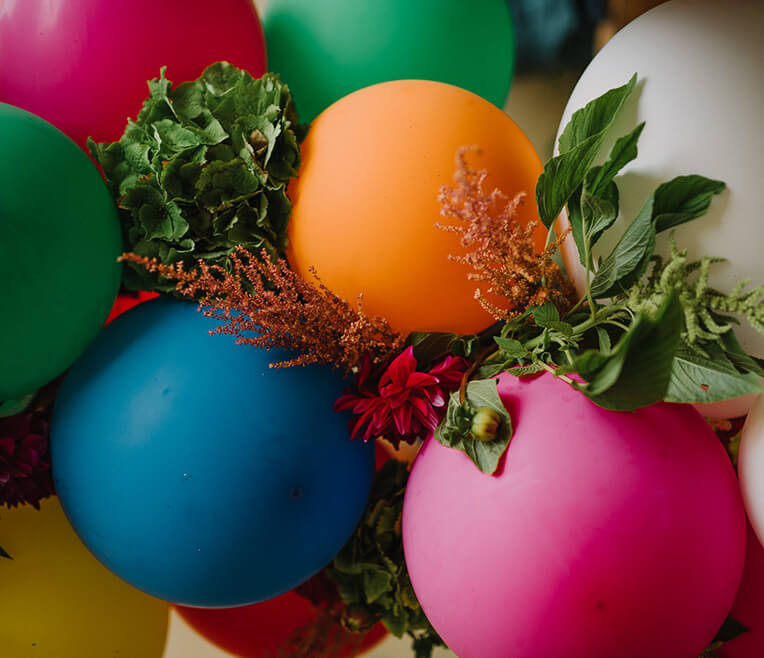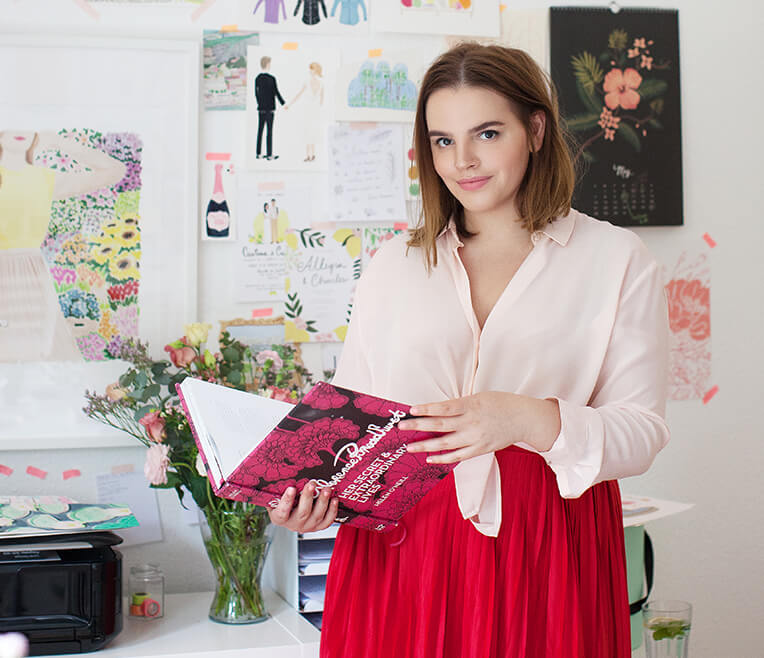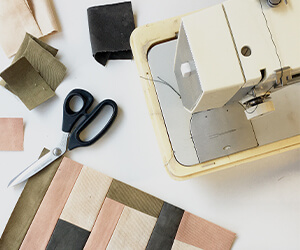
DIY Idea for a Patchwork Bag
Do you feel like trying the patchwork technique? Here is a DIY idea for a stylish and so beautiful patchwork bag by Ania von kaliko.com. Have fun making it!
- DIY Production & Photos : Ania Grzeszek
Patchwork Bag by Kaliko
Materials
- sewing machine
- iron
- roller cutter
- scissors
- ruler to help you cut
- cutting mat
Instructions
1. What you need
Start with fabric scraps of your choice. I always choose the colors first, usually sticking to 4-5 hues, and making sure they have a nice contrast between them. I try not to mix light weight and heavy weight fabrics. The scraps in this tutorial are heavy weight cotton canvas pieces, colored with plant dyes. You’ll need a sewing machine, iron, roller cutter, scissors, a ruler to help you cut and a cutting mat. Before you start, cut out the final size you are aiming for from a piece of paper. You will need this pattern to plan your composition.
2. Trim your scraps
Unless you start with super neat edges, you will need to trim them. I always make sure both sides of the piece are parallel to each other. It makes planning and sewing much easier. It is of course possible to work with diagonal lines, too, but if you’re first starting out, making an orthogonal pattern will make your life easier. Don’t worry about the length of your scraps just yet, we will tackle that in the next step.
3. Arranging patches
I always start with arranging the scraps on the working table. It is an intuitive process, but there are a few things to keep in mind. Start with making small blocks, adding one piece at a time. This way you will make sure it is possible to sew them in this order, too. This pattern is made of four main blocks, each block made of 3-4 scraps in, each of them in different color, too. When putting the blocks together, try to make sure no scraps of the same color lie next to each other. I don’t cut the scraps just yet, but fold them to see how they work together. I can always unfold them at this point and extend if I need to. Final tip – if working with a thick fabric like heavy weight canvas, never put more than three edges next to each other. Have a look at my composition – there is no spot where four scraps meet. It is a deliberate planning because otherwise the patching gets too bulky. When it you are happy with the composition, check if your cutout pattern is all covered. Leave at least a few centimeters on each side. The piece will get smaller when you sew the pieces together, so you need enough seam allowance. Better too much than too little!
4. Plan the sewing sequence
Now it’s time to cut the scraps. I use scissors and trim them roughly. I don’t mind if they are a few centimeters too long; they’ll get trimmed later. But you want to have a rough outline for your process. As you can see, my pattern consists of four main blocks, each of them made of 3-4 scraps. These four blocks will be connected at the very end – starting from the top middle and top right corner, then attaching the bottom block and finally adding the left block. But before that can happen, I need to sew the scraps within each block. As you might already see, for the top right corner block, the sewing sequence will go as follows: sewing beige and peach, then adding dark grey, then adding moss green. I will use the same principle for all other blocks, adding one scrap at a time.
5. Start with the smallest block
I start with beige and peach. I know which sides will be connected as I planned it in advance. I put the pieces together – along the edge that will become a seam, right sides facing each other. A quick note here: I work on all four blocks simultaneously. I start with the smallest piece in each block and keep adding next scraps as I go.
6. Sew the pieces together
Sew ca. 0,5cm from the edge (0,25 inch). You don’t have to backstitch your seams, they will be held by the consecutive seams, as you keep adding next patches. Once you open your first small piece, you will notice it folds back together as soon as you release it. Don’t lose track of your composition and always keep it flat on the table.
7. Press the seams
In order to see the layout you need to press the seams flat open. I am pressing all four patches, each form one of the 4 main blocks. As said, I work on all blocks simultaneously, but you don’t have to do that. What you have to do, though, is to always press all seams as soon as you sew them. It is crucial step for adding next patches as you go, otherwise the pattern won’t sew properly and will look bulky once you finish.
8. Keep the pieces straight
First pieces are finished! Because my scraps were all different widths, I now trim them, so that they are straight again. I do that after each scrap I add.
9. Always add one patch at a time
I am adding the third fabric scrap to the two I sewed together before. The seams are now pressed down and lay flat. I always put the piece I am adding to the bottom, keeping the seams from the previous building block facing up. This way I can keep an eye on them and make sure they don’t fold as I sew. It is important to keep them flat with this next stitch. Just like before, the right sides are facing each other, and the wrong sides are turned to the outside.
10. Keep extending the blocks
Keep adding one piece at a time. The composition is now slowly growing. Remember to iron the seams after each round of stitching and keep the seams open when sewing consecutive scraps. Trim the pieces before sewing the next patch, to keep it flat and neat.
11. Many seams later…
At this point all the four main blocks are made of 3 colors patched together. In two blocks the final scraps are still missing. Now I am adding the final scraps to the last two blocks. Once it’s done, I will press them again, trim, and start connecting the blocks into the fully patched piece.
12. Connect the main blocks
Just as planned at the very beginning, I connect the blocks in the following sequence: starting from the top middle and top right corner, then attaching the bottom block and finally adding the left hand block.
13. Finishing the patchwork
Looks like it’s done! I press the seams with an iron one last time. They all need to lay flat, so that the scraps don’t bulk in the front. This is how the right side should look like before you trim the piece for the last time – nice and flat! Make sure all the seams are pressed well.
14. Troubleshooting
When I checked with my cutout pattern, it turned out the piece is too narrow. It happens a lot when I am working with small scraps, but it’s not a problem. I just take a color that was not yet added to the block I’m extending – moss green – and sew it to the edge.
15. Cut to the pattern
Once the piece is big enough and all seams are pressed, I cut it to the final size. I like using see-through tracing paper, so that I can position the seams away from the edges.
16. …and done!
I made another piece for the other side of the bag, using the same colors. I chose matching fabric for the bottom of the bag and for the drawstring tunnel. Both sides are different but corresponding in colors.
17. Patchwork project bag
This is the final product – a plant dyed patchwork bag made with our production scraps. Completely unique and one-of-a-kind.




